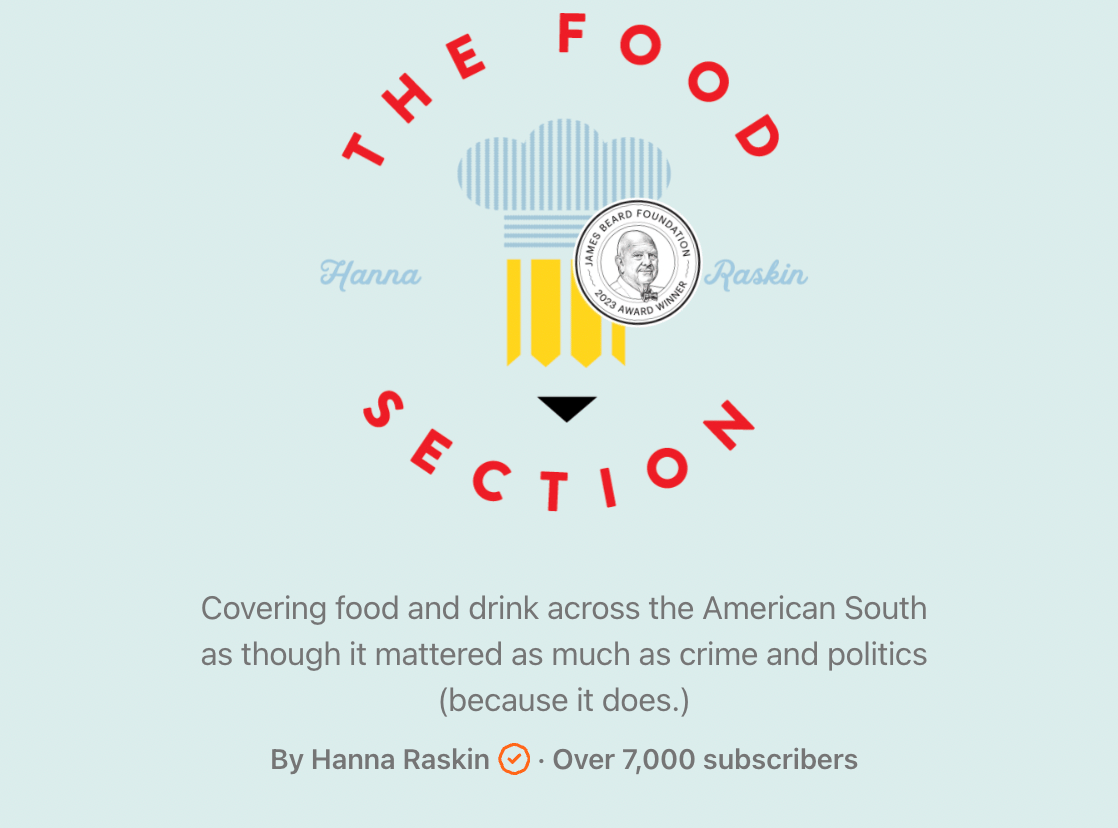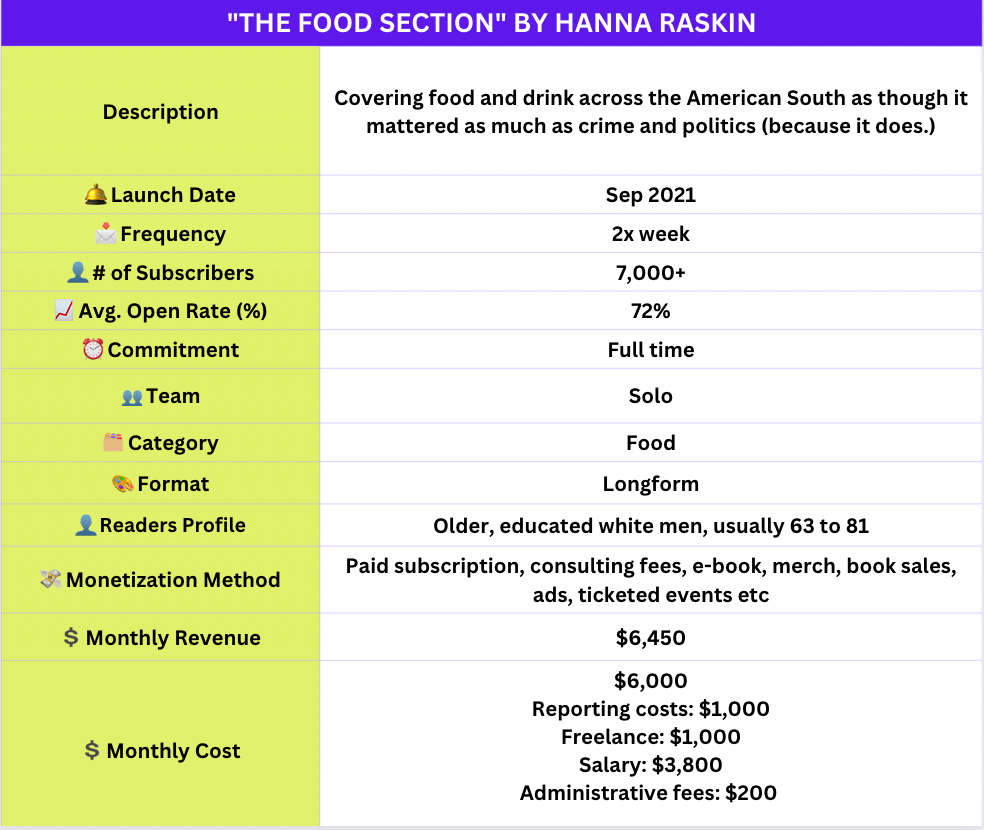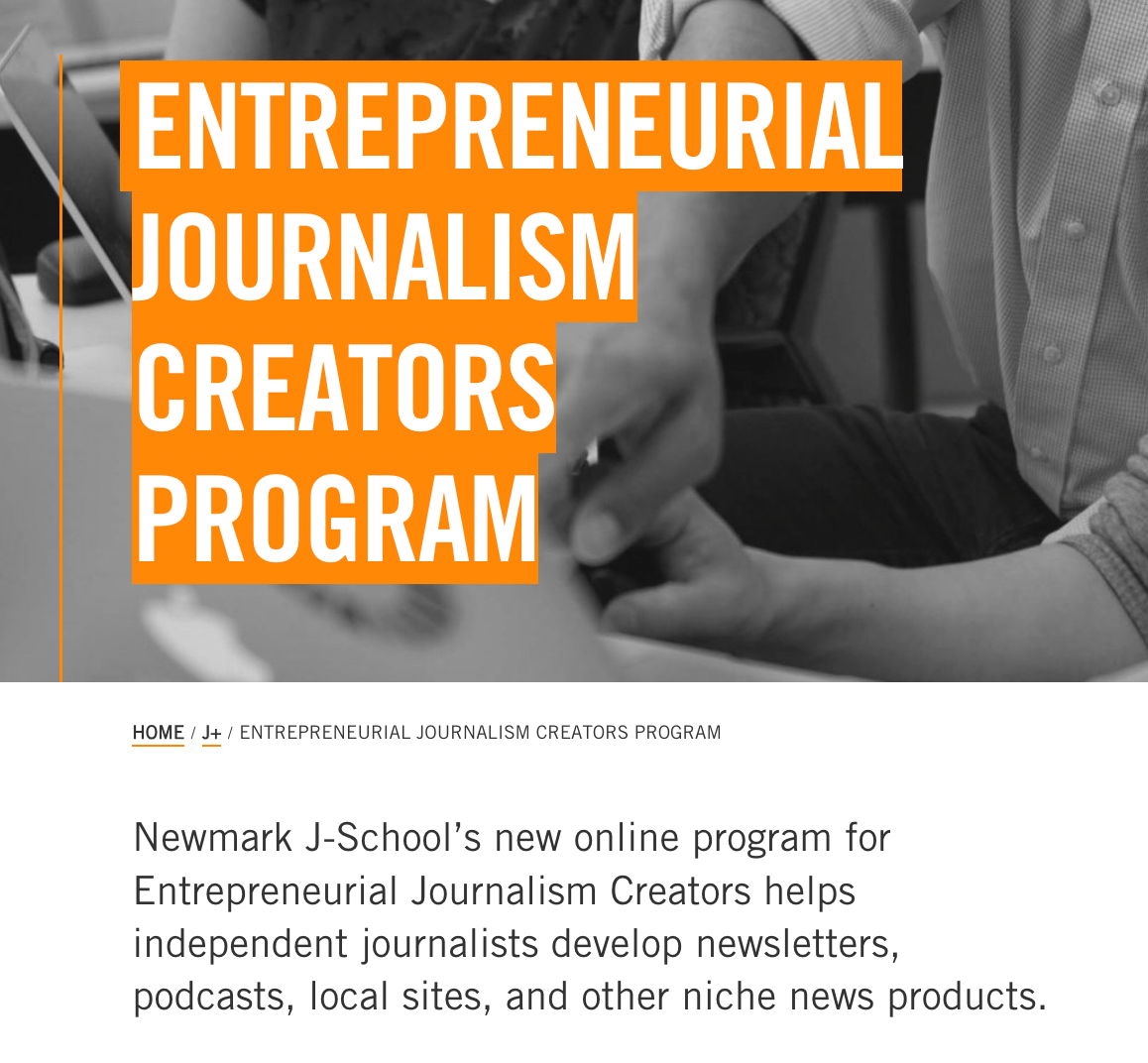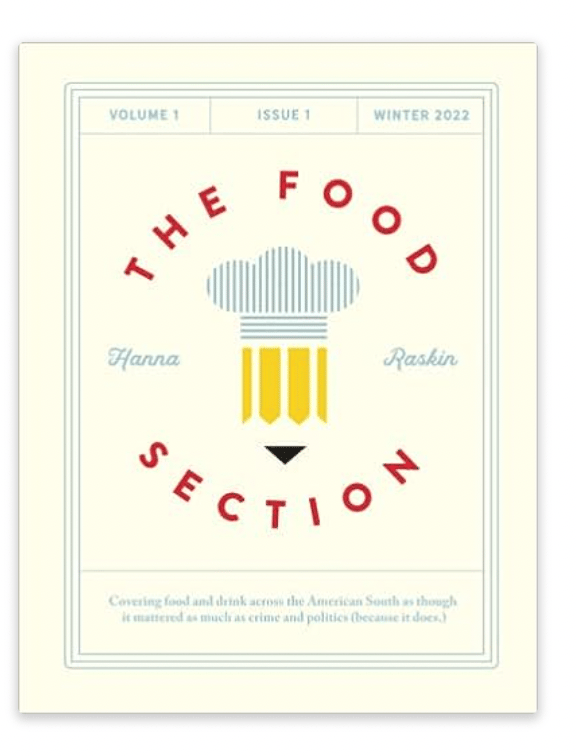Learn the secrets of successful newsletters with Newsletter Circle!
👉 Every Sunday, you will read an exclusive interview with a successful newsletter creator and learn how to start, grow and monetize your newsletter.
🎙8 UNCONVENTIONAL GROWTH STRATEGIES
This week I wrote a deep dive for Matt McGarry’s Newsletter Operator as a guest post.
→ Check it out here to learn 8 examples of “unconventional” growth strategies that you can integrate into your newsletter business.
P.S. Newsletter Operator is one of my favorites as a newsletter creator and I highly recommend you follow him to learn how to grow and monetize your newsletter.
🎙CREATOR INTERVIEW
Hanna Raskin is a successful food journalist and the mastermind behind the multiple-award winning publication “The Food Section”, covering food and drink across the American South.
Having departed from her full-time role as the food editor and chief critic at the Post and Courier in Charleston, South Caroline, Hanna launched her newsletter in Sep’21.
Since then she reached over 7,000 subscribers achieving an impressive open rate 72% with hundreds of paid subscribers and $6,450 monthly revenue.
The Food Section is not a typical newsletter from the food space that you can find recipes. Hanna, as a food journalist, uncovers the economic, political and social influences behind the food choices in the region and contributing to the community’s better understanding of the culture that surrounds them.
Moreover, she is very successful at cracking the code of establishing a sustainable newsletter business. She experiments bold growth tactics and manages to diversify her revenue sources.
She kindly answered my questions about how she built “The Food Section” successfully.
Let’s dive into!
🏷 NEWSLETTER IDENTITY CARD
🛠 Tool Stack
👋 MEET THE CREATOR
Welcome Hanna. Let’s start with getting to know you.
I’m editor and publisher of The Food Section, covering food and drink across the American South.
I launched the publication in September 2021 after spending close to a decade as a food editor and restaurant critic of The Post and Courier in Charleston, South Carolina. Prior to joining the newspaper’s staff, I held the same title at a series of alt-weeklies.
🥁 START
What is The Food Section all about?
Our mission at The Food Section is to serve eaters across the American South by providing them with the information and analysis they need to enhance their food and drink experiences.
The Food Section specializes in original, inclusive, and independent reporting on the cultural, political, historical, and environmental forces that influence how and what we eat and drink in the region today.
After leaving your full-time job, how did you decide that “a newsletter” would be an ideal format for the content you aim to create? What led you to believe in the potential of newsletters?
And, why and how did you decide to start The Food Section in the first place?
I blame Dave Infante, publisher of Fingers.
Dave’s a friend and fellow food writer who knew I was eager to take the brand of hard-hitting food journalism I’d developed beyond the South Carolina Lowcountry, particularly after the pandemic revealed the significance of restaurants in the realms of economics, public health, and social justice. He suggested I apply for a Substack Local grant. I’d forgotten I’d submitted a 100-word pitch for funding until I was notified I’d received it.
In other words, Substack isn’t an ideal platform for what I publish, which is closer in spirit to a digital magazine than a newsletter. But I was happy to take the seed money.
One of the things that make your newsletter unique is how your approach the food topic, which is from the perspective of “food journalism”. You also participated in “Entrepreneurial Journalism Creators Program - Newmark J-School”.
What is “food journalism” to begin with? How did you decide that people want to read such a newsletter from the food space?
Food journalism is just journalism about food, which means it’s concerned primarily with holding power to account and helping people better understand the communities in which they live.
“As The Food Section’s motto says, I cover food and food culture with the same rigor and ethics that other reporters apply to the city council or the courts.”
Based on the longstanding reader response to that approach, I had no doubt it would be well received by people living in places where serious food journalism isn’t actively practiced.
→ Readers should also consider applying for the program. The deadline is September 8.
Ciler’s note: Jeremy Caplan, who is the Director of Teaching and Learning at CUNY's Newmark Graduate School of Journalism, also shared how he built his newsletter Wonder Tools in Newsletter Circle previously. You can read this issue here.
You won “The James Beard Media Award” in June, in addition to many awards that you’ve won previously. Congrats on this!
Can you explain what this award is about and why it is a huge success to win it as an independent newsletter?
I habitually enter awards contests for two reasons:
One, I never won awards as a kid, and I’m probably still trying to compensate for that feeling of being overlooked. (Did I mention both of my parents are psychotherapists?)
“Two, and much more importantly, award wins are terrific earned media. Just getting my name on a list with the nation’s biggest and most respected food publications is useful from a promotional standpoint.“
Several of The Food Section’s awards are listed here.
The Beard is a big one because it’s a name that folks outside of the insular world of journalism know, but I’m especially proud to have been recognized by the Society for Features Journalism, International Association of Culinary Professionals, and Online News Association.
🚀 GROWTH
What I see as a common thing among successful creators is their willingness to know their audiences better.
What do you do to get to know your subscribers?
This is another reason that Substack is a poor fit for The Food Section, since the system provides astonishingly little information about readers.
For instance, I can’t pull out just readers based in Alabama and poll them–and, in my experience, targeted surveys are more successful in terms of both participation and actionable insights.
“But to make up for that data gap, every Monday, I individually email each person who added his/her/their name to The Food Section’s free list since the previous Monday, explaining the newsletter’s paywall and concluding with the question, “I'm curious where you live--and one restaurant you'd suggest visiting there.”
It’s a conversation opener that leads to about one paid subscription for every 12-15 emails sent. I try to keep up and develop that conversation at in-person events throughout the year.
How did you gain your first 1000 subscribers (non-paying readers)?
Having previously served as president of the Association of Food Journalists, I had a very strong professional network.
What are the most effective growth strategy & channels?
“Once a month, I publish a 1200-word feature authored by a freelancer because a broad spectrum of voices is essential to telling the culinary story of the whole South. “
I pay $1000 for the contribution since fair compensation is one of The Food Section’s core principles. But in return, I reach the writer’s regular audience and the communities they cover, both of which are typically made up of people who’ve never before heard of the newsletter.
Regarding growth efforts, what would you do differently if you had a chance to start over?
To get the word of the newsletter out to newspaper readers wondering where I went, I purchased public radio sponsorships, in deference to early audience surveys that showed my first paying subscribers were devoted public radio fans.
I’m pretty sure I could have found a better way to spend that $500, although who knows? As the truism goes, people have to hear about your product half a dozen times before the message registers, so maybe those top-of-the-hour readouts chipped away at some newspaper readers’ resistance to switching publications with me.
💸 MONETIZATION
How do you make money with your newsletter? How much do you earn?
A million little ways: I’ve arranged for independent bookstores to carry The Food Section’s print edition. I sell merch. I host occasional ticketed events. But the main revenue stream is paid subscriptions, supplemented by consulting fees and partnership deals with other independent news organizations.
My monthly revenue is $6,450.
How did you start paid subscription and how did you shape your pricing strategy?
“I offered a paid subscription from day one: There is no upside to turning away money that people want to give you.”
But I agonized over how much to charge. I knew I needed a certain amount to underwrite the kind of quality journalism I planned to produce–travel, professional editing services, and government documents aren’t cheap!--but there was no way to know how many people would subscribe at each price point. It’s tricky solving for x and y simultaneously.
On the advice of Michael Shemtov, I read William Poundstone’s Priceless: The Myth of Fair Value (and How to Take Advantage of It) and settled on $9 a month, $99 a year. I was able to halve those prices after I partnered with The Assembly, making The Food Section more of an impulse buy.
What are your biggest learnings when it comes to converting free subscribers into paid ones?
My free readers don’t convert.
“According to my data, folks who don’t pay up in the first 72 hours are unlikely to ever pay, apparently, people pay in anticipation of what they’ll receive instead of gratitude for what they’ve gotten.”
In short, I’ve learned not to waste time on conversion.
Do you have any plans to increase your revenue?
The Food Section opened its first bureau this year. I’m looking forward to opening additional bureaus in other Southeastern cities, with the goal of producing localized newsletters for eaters in underserved areas.
What was the most unconventional experiment you have run so far? How did it result in?
By far, the decision to randomly ax free readers from my email list. I reviewed “The Cull” in detail with Dan Oshinsky here.
📩 E-MAIL SERVICE PROVIDER
Why did you choose Substack?
Nah, it chose me.
🧩 SYSTEM & PRODUCTIVITY
What is your typical weekly process from creating to distributing a new issue?
I budget stories about three months out, and like to have everything filed and ready to publish at least two weeks in advance.
I’m generally out in the field about 10-12 days a month; on non-reporting days, I’m at my desk from 8-6, calling sources; conducting research; writing; and tending to administrative tasks.
🎢 NEWSLETTER EXPERIENCE
How did writing The Food Section contribute to your life?
Professionally, it’s been challenging and intellectually stimulating. I’d sort of fallen into a rut at the paper.
What is the most challenging part of writing a newsletter and how do you handle it?
Running a business isn’t philosophically compatible with journalism since the latter is contingent upon skepticism and humility, and the former requires you to say with confidence that you’ve created the best product on the market.
🎯 FUTURE
What is next on your newsletter journey?
Migrating off Substack.
📌 RECOMMENDATIONS
What would it be if you had the right to give one piece of advice to aspiring newsletter creators?
Know your newsletter’s purpose and stay true to it.
What are your favorite newsletters that you can’t wait for the next issue?
Honestly, I’m not a big newsletter reader. According to my Substack profile, I’m subscribed to 13 newsletters, and I know at least two of them are on extended hiatus. But I’ll put in a plug for my fellow Substackers in North Carolina–exceptional journalists all: Tony Mecia of The Charlotte Ledger, Jason Sandford of Ashevegas Hot Sheet, Tommy Tomlinson of The Writing Shed, and Jeremey Markovich of North Carolina Rabbit Hole.
(And yes, I know I just listed four white men. Tell me about other Tar Heel Staters I ought to read!
👋 FINAL WORDS
I’m always available to talk to solopreneurs about their journalism projects. readthefoodsection@gmail.com
Thank you so much, Hanna. Wishing you all the best for your newsletter journey.
🔗 Where to find Hanna Raskin and her work
Hanna Raskin Twitter
Hanna Raskin LinkedIn
Hanna Raskin Instagram
Hanna Raskin e-mail: readthefoodsection@gmail.com
That’s all for today. Thanks for reading.
See you next week.
Ciler
📌 P.S. I’ve switched from Substack over to Beehiiv (here). But don’t worry; you don’t need to do anything; I will manually add you to my Beehiiv list if you subscribe here. This is just for you to know :)
And don’t worry; you will receive the new issues only from “cilerdemiralp.beehiiv.com”, no duplications.








